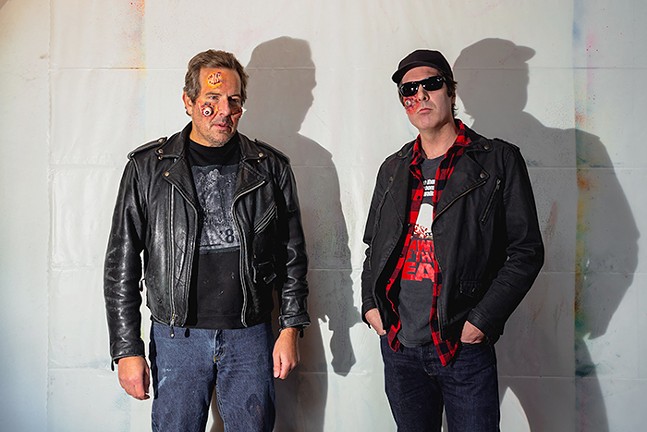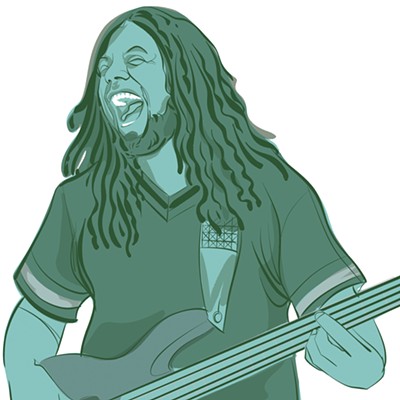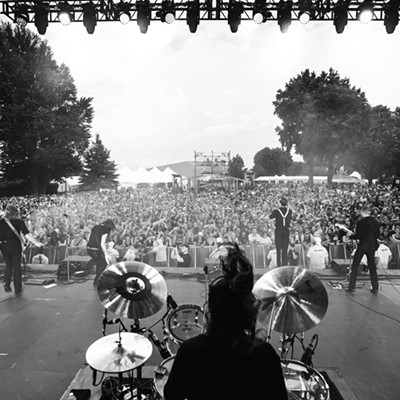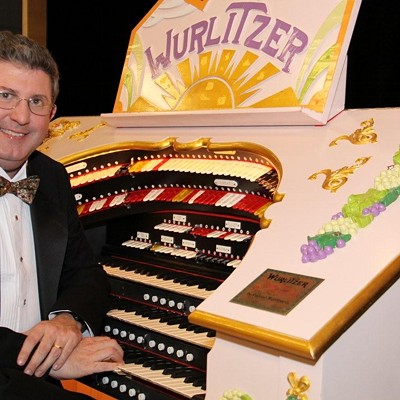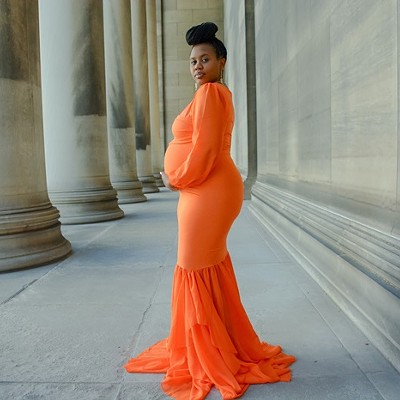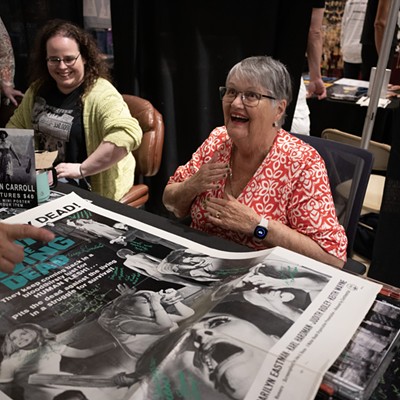Since the late-90s, Wolf Eyes has pushed the envelope of experimental music, touching on styles such as avant-garde jazz, tuneless industrial noise, electronic folk, and general mechanical trickery.
Their latest album, Difficult Messages, released Jan. 27 from Disciples, is a self-described COVID lockdown project. It’s compromised of 11 collaborative tracks from within the Wolf Eyes universe, featuring songs created with Alex Moskos, Gretchen Gonzales, Aaron Dilloway, and Raven Chacon, as well as music from Stare Case and Short Hands, two offshoot projects from Young and Olson. Most of the music was made remotely, an unfamiliar recording process that resulted in an album with all the typical Wolf Eyes craziness but stripped down to its most basic, raw form.
Inspired by Michigan’s rich legacy of jukebox-friendly Motown singles and 7-inch punk releases from DIY labels, the songs on Difficult Messages were originally released as singles in limited-run “art box” vinyl sets in 2021. The songs now find a home with the masses as a single LP. Described on their website as a “carnival of shadows that mirror the grim landscapes of the mind,” Difficult Messages is a fascinating time capsule of a slowed-down era when self-reflection was one of the only things to do. Thankfully, Wolf Eyes found something to make out of it.
Pittsburgh City Paper spoke with Young and Olson ahead of Wolf Eyes’ Difficult Messages tour, during which they’ll be playing a show with Gundy, Alamoans, Cloning, Nasty Taxi, babyt33th, and Charle Wallace on Fri., Feb. 24 as part of Collision's underground music events.
So your new release, Difficult Messages, is a compilation of collaborations. What made you guys want to release this kind of album?
NY: Well, it was our COVID project, for one. We wanted to do something that was really just to cope, really to entertain ourselves. I think everyone had their different ways of coping; this was ours. Originally, it was released as a box set of private press 7-inches. There were like, 50 of each of the 7-inches, and there were four editions with four 7-inches in each painted box. I'm sorry, that's probably a mouthful for you. But you get my drift. It was an art object that we made to entertain ourselves. We had no real intention of releasing this music broadly. That said, you know, we did make it available to the public, but a very small amount, and mostly we gave away a lot to our friends.
JO: Well, another impetus of it was that we were looking around at pressing plants, and we found one that did it real fast. So, we tried out a Stare Case 7-inches, and it came back real fast. And we were really happy with the result.
NY: That kind of speaks even more into why we did it. We have a lot of different side projects. I mean, I don’t call them side projects — we have a lot of different bands, Johnny and I. On any given day, I get confused on what actually we're rehearsing — is it Stare Case, is it Short Hands? So, I think that's huge — just us embracing our discographies and blurring all those lines. Because I don't know, it's cool to have a bunch of different bands, but it also, you know, creates sort of restrictions, and getting rid of those restrictions is definitely a part of the whole COVID coping mechanism — just freeing up our repertoire to do whatever we wanted to do under any new names.
Nothing really mattered, and yeah, like I said, we never really intended to release this. We just found ourselves sharing it with our record label.
How did recording the songs remotely during quarantine affect the creation of the album?
JO: Oh, it’s fascinating.
NY: We found ourselves making music for each other, you know, and therefore, like, trying to entertain each other a bit more. And, you know, things got ridiculous. Things got scary, too. I mean, yeah, things got abstract.
I’ve read you, Nate, describe the album as being a return to older Wolf Eyes concepts of dissonance and discomfort. Why did the album gravitate in that direction?
NY: I think I also said newer concept as well. It really is about reconnecting with our body of work. I mean, at a certain point, our discography becomes vast even for us to look at. And during COVID, we had time to really examine that, and look at what we had done in the last 20 years, you know. Before that, I think we were consumed by touring. And everything that we would do was sort of motivated by that job. By that practice, I mean. That's the thing, we don't look at touring any different than, like, painting. It is a practice, an artistic practice. And when that got taken away, we had to find new ways to satisfy that, and, let’s be honest, new ways to create income.
And we made a real clear decision, like, we don't think people are that interested in widely distributed records by us right now. That's not very important. People are dying everywhere, like, who cares if we put out a record? Who the fuck cares? But we’ve instead taken the idea of the practice of being artists and taken it right back to just making art for ourselves or each other. And in that way, maybe that helped this record reach a wider audience, you know? Does that make any sense to you?
JO: Another aspect to it was that Michigan, with Motown and Touch And Go [Records] and everything, is so single, 7-inch heavy. The 45 [rpm record] around here is heralded. Northern soul is based upon the 45. So, to approach absolutely alien, abstract music like ours into a format that is supposed to be made for a jukebox, or just a really quick experience, like radio play, was a killer challenge.
NY: We noticed that our normal cycle for playing music, for improvising, for live performance, happens in about 10-minute spurts. We started noticing this and tried to sort of trim it down, the old shaving-the-toothbrush technique, you know, trying to make it as functional and streamline as soon as we possibly could. And once we got that, things just started opening up and new bands formed and completely new, new ideas. And, like I said before, old ideas that we had walked away from. Harsh, harsh, brutal electronic — raw, like, super simplistic.
JO: My favorite sounds.
What are your relationships to the machines and instruments that you manipulate to make such raw and harsh music? Do you have staples that you've used across albums? Or is it a process of finding new technology to use and learn each time?
NY: Well, again, looking back on our discography and the instruments we've used, this all happened during COVID. We were always moving forward. And I feel like we still are, of course, but we never had time to reflect on our relationship with our machines, with these machines that we made ourselves or modified ourselves in the early days, having no idea how or why things were working or doing what they were doing. Looking at all that, we started to realize that our instruments are such an extension of ourselves now, that typically we dress just like them, too. I'm not even kidding.
JO: Nate pointed it out at a practice, and it fucked me up real bad because the color schemes and the style and everything was the instrument. It was just like, goddam, and it's totally true.
NY: Even if you look at what Olson's wearing right now, which I'll describe for you— he's wearing camo pants, a grey sweatshirt with like a weird screen-print with spray paint splattered on it. But, you get the idea, some crazy sauce, and I go over to his setup and what do I see? A weird flashing gray instrument and like a big spray-painted other thing.
Same with me. I'm wearing black jeans with some bold lettering. It says DeWalt; it’s my favorite hoodie. It’s got bright yellow on it and, actually, one of my instruments is just black with bright yellow LEDs. Yeah, it goes really deep with us. Because it's sculptural, but it's also, you know, we're artists. These are our sculptures, this whole thing.
JO: It's more found us than we found it. You can’t run from it, man.
NY: Like, I have this one instrument that creates our bass baselines and sort of subtle structure. But it's a randomized machine; I have no control over it whatsoever. But, if I go and look, like if I try to find a baseline — fuck me. It's nowhere. It's just the most horrible sounding, like “blooh, blooh.” Like, I can't use that shit. But if I just look away and then look back, then suddenly it's playing this eerie, perfect simple structure. And I'm like, there it is. What the fuck?
JO: They made a movie about that called It Follows. Don’t look for it — it’ll find ya. It's like someone from Michigan — you ain't gotta ask, they'll tell you.
Speaking of playing live, how much of your live sets are rehearsed and how much is improvisation?
NY: It's 70-30. To tell you the truth, we do have very rehearsed tracks. But, even within those tracks, there's the 70-30 relationship again, staring back at you. So, yeah, either way. It's a mirror looking at a mirror that says 70-30.
JO: Well, the avant-jazz pianist Lennie Tristano said you can only really experiment and take an adventure unless you're completely relaxed and open to it. So, there's a lot of that as well, you know.
NY: Again, the best way to find something — just let it go.
JO: Let it come back and bite ya.
I wanted to ask about your music videos and album art and all the visual aspects of your music. Do the creation of those things typically follow the recording process or do you ever start out with an image in mind and then music follows from there?
NY: We do a lot of making of images and then pairing it with sound, but the music videos are more like documents of, you know, the process, really. They're made after the fact, definitely. But the album artwork we always consider while we're mixing and compiling material. The artwork is right there hand-in-hand. And you know, it's a chicken-and-egg situation, we're not sure sometimes which came first. But, it's always considered, and everything is very married in a really, like, good way. It's a long relationship.
JO: Sometimes all it takes is a phrase or a word.
Wolf Eyes has been a band in some form for over 20 years. What drives both of you to keep experimenting and creating new things?
NY: Well, it's a practice. So, we just sort of exist. Like, we feel that this is the most responsible thing we can do at this point. To just continue creating and treating this like an artistic practice rather than thinking, you know, “we’re postmodernists.” I don’t think in masterpieces. I don't think in those terms — or memorization, for fuck's sake. Like, fuck all that. I think in a lot more simple, satisfying terms with my work and how I want to live, you know, and they go hand in hand. So yeah, the future for us looks just like today, this beautiful day.
JO: Can’t run from it. We’ll be here making stuff.
Wolf Eyes with Gundy, Alamoans, Cloning, Nasty Taxi, babyt33th, and Charle Wallace. 8 p.m. Fri., Feb. 24. Collision. $13 advance, $18 at the door. tcrps-prsnts.ticketleap.com/wolf-eyes

